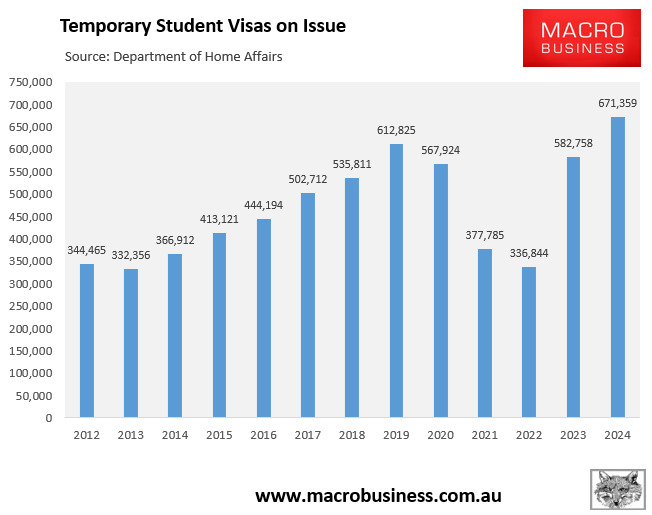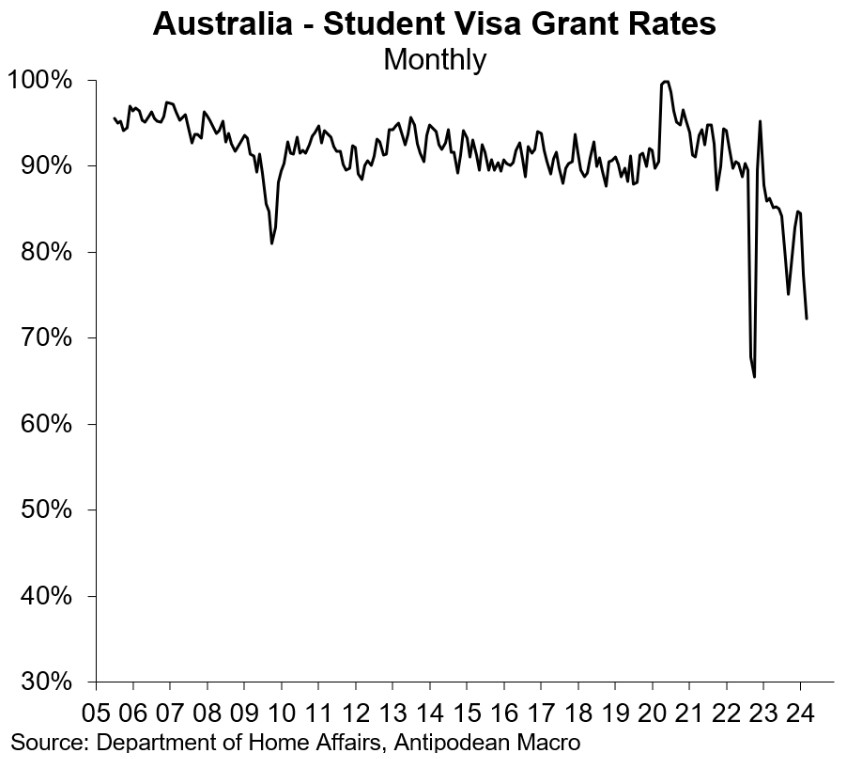The latest temporary visa data from the Department of Home Affairs shows that the total number of student visa holders in Australia rose to 671,000 in March 2024, up 60,000 from the 2019 pre-pandemic peak:

The total number of graduate visa holders has doubled over the pandemic to a record high of 200,000:

This means that roughly one out of every 30 people in Australia in March (860,000) was on either a student or graduate visa—an astonishing number.
The good news is that the Albanese government’s “crackdown” on non-genuine students and dodgy applications is having a belated impact.
As the following charts from Justin Fabo at Antipodean Macro show, student visa grant rates have fallen sharply this year, pointing to fewer numbers ahead:

This decline in student visa grants has been driven by vocational education and training, followed by independent English-language courses:

According to The AFR, visa approvals for applicants from India (to 37,000), Colombia (to 24,900), and Nepal (to 14,200) roughly halved in the first eight months of the financial year compared with the prior corresponding period.
Universities and private colleges enrolling non-genuine students have been hit hardest by the decline in applications, with Ballarat’s Federation University faring the worst:
Federation University is among the smallest public universities in Australia, with just 13,344 students in 2022.
Vice chancellor Duncan Bentley said international student numbers had crashed from 8600 in 2020 to 3500 this year.
“That’s a drop in revenue of around $80 million,” Professor Bentley said.
Just 384 new overseas students have so far enrolled for 2024. In 2019, the figure was 4743…
Federation is one of only three public universities, including University of Tasmania and University of New England, to have the highest risk rating from the Department of Home Affairs. That means those universities and their partners have been identified as enrolling too many non-genuine students, or people using student visas, as a way into the jobs market.
As a result, all overseas student applicants to Federation had to undergo additional intense scrutiny by migration officials.
The most recent remarks from Opposition Education spokesperson Sarah Henderson would surprise anyone who had hoped that the Coalition would provide a more robust migration policy.
In a classic case of political double-speak, Henderson argues that Labor has irresponsibly issued too many student visas, but that it would be irresponsible to do anything about it because of jobs, export earnings, and it “might jeopardise our relationship with India”:

“The Albanese Government’s discriminatory and covert student visa policies are hitting regional and smaller universities hard, along with private higher education providers”, Henderson said via the media release accompanying her letter.
“With students from India and some other countries being targeted by the Albanese Government, Minister Clare must also explain how he intends to preserve Australia’s standing as a provider of international education”.
This sort of behaviour is par for the course with the Coalition, which frequently attack’s Labor’s “reckless” immigration, while also supporting high immigration policy settings.
Who would forget leader Peter Dutton’s claim after the September 2022 Job & Skills Summit that “it’s clear the number [immigration] needs to be higher”.
Dutton also wholeheartedly supports Albo’s Indian visa tsunami:
“I think there is an opportunity … for us to continue to scale up [higher education exchange], and there’s a lot of domestic interest in making sure that’s the case.” pic.twitter.com/Ns39bHq348
— Will (@SouthWillsy) November 5, 2023
Dutton said in a speech to India’s Jindal Global University in November 2023:
“Between 2015 and 2022, Indian temporary visa holders increased from around 140,000 to 283,000. An average of around 32,000 Indians migrated permanently to Australia each year”.
“And more than 209,000 Indians became Australian citizens”.
“Tellingly, the number of Australians with Indian ancestry numbers more than 780,000, some 164,000 more since the 2016 Census- something of which I am incredibly proud”.
“Indeed, there is a strong bipartisan support between the two major political parties in Australia when it comes to nurturing migration with India”.
“When Prime Ministers Modi and Albanese met in Sydney in May, they finalised a Migration and Mobility Partnership Agreement”.
“That arrangement will facilitate a greater two-way flow of students, of graduates, of academics and business people”
“It’s an initiative I welcome wholeheartedly”.
During question time, Peter Dutton also said that he wants more Indian students coming to Australia:
“When you consider the trajectory of student numbers… there is considerable growth, which we welcome”.
“The students provide not only an important role in their education, but also in the advancement of the Australian economy and society as a whole”.
“I think it’s one of the great modern accomplishments of Australia is to have welcomed so many students from India”.
“There is, I think, an enormous opportunity in Prime Minister’s Modi’s vision and our vision for the Australian economy as well, being able to export that labour, intellect and capacity, the entrepreneurial spirit is something that Australia is a net beneficiary of”.
“So, I think there is an opportunity through private institutions and other public institution collaborations for us to continue to scale up, and there’s a lot of domestic interest in making sure that’s the case”.
Under the Mechanism for Mutual Recognition of Qualifications, which was signed in May, “Indian qualifications will be recognised in Australia” for the purposes of further study and general employment.
This mutual recognition of qualifications extends to secondary school, vocational, and university qualifications, many of which can be obtained via one of India’s many ghost colleges.
Prime Minister Anthony Albanese also signed the Australia-India Migration and Mobility Partnership Agreement this year, making it easier for Indian students, academics and professionals to live, study and work in Australia.
This agreement includes the following provisions that are incredibly generous to Indian ‘students’:
- Five year student visas, with no caps on the numbers of Indians that can study in Australia.
- Indian graduates of Australian tertiary institutions on a student visa can apply to work without visa sponsorship for up to eight years.
Two-thirds of India’s 1.4 billion people are under the age of 30, making it the world’s youngest and largest nation.
India’s unemployment rate was 7.6% in March, roughly double that of Australia, and the percentage of unemployment among Indian youth is above 20%.
Accordingly, there is a huge underclass of young, poor Indians who will be eager to relocate to Australia to live and work.
In turn, Australia’s net overseas migration will remain persistently high, bringing with it permanent housing and infrastructure shortages, low productivity growth, stagnant real wages, a degraded natural environment, and falling living standards.
When will Australian politicians govern in the interests of Australians? Because Labor, the Coalition and the Greens do not seem capable of doing so.

